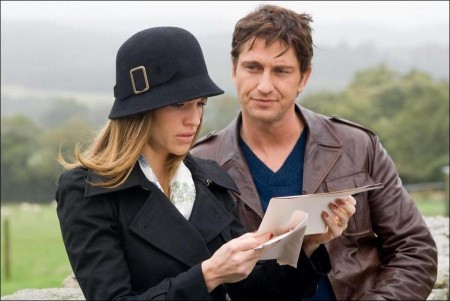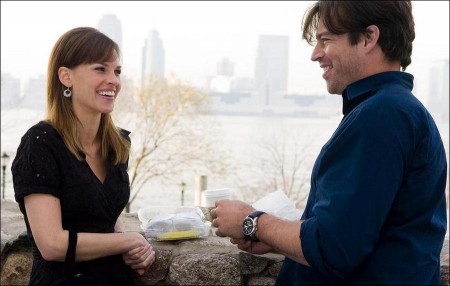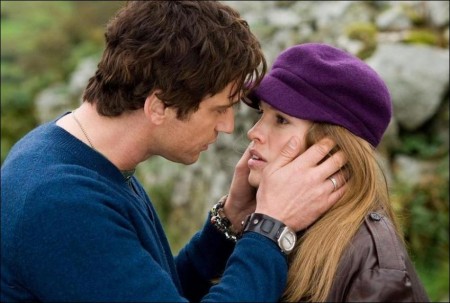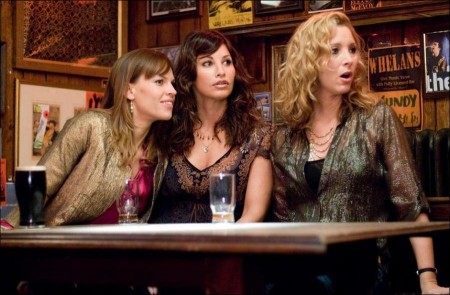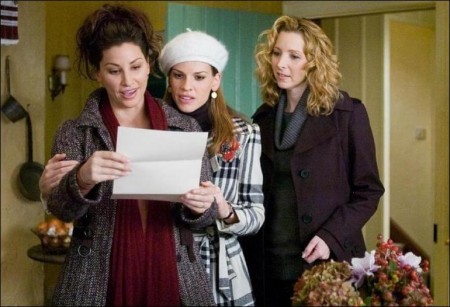Tagline: Sometimes there’s only one thing left to say.
An adaptation of the best-selling Cecelia Ahern novel about a grieving young widow who discovers her late husband has left her a list of tasks revealed in 10 monthly messages that are intended to ease her out of grief and transition her to a new life.
Holly Kennedy (Hilary Swank) is beautiful, smart, and married to the love of her life-a passionate, funny and impetuous Irishman named Gerry (Gerard Butler). So when Gerry’s life is taken by an illness, it takes the life out of Holly. The only one who can help her is the person who is no longer there.
Nobody knows Holly better than Gerry. So it’s a good thing he planned ahead. Before he died, Gerry wrote Holly a series of letters that will guide her, not only through her grief but in rediscovering herself. The first message arrives on Holly’s 30th birthday in the form of a cake and, to her utter shock, a tape recording from Gerry, who proceeds to order her to get out and “celebrate herself.”
In the weeks and months that follow, more letters from Gerry are delivered in surprising ways, each sending her on a new adventure and each signing off in the same way: P.S. I Love You. Holly’s mother (Kathy Bates) and best friends, Sharon (Gina Gershon) and Denise (Lisa Kudrow), begin to worry that Gerry’s letters are keeping Holly tied to the past, but, in fact, each letter is pushing her further into a new future. Holly embarks on a touching, exciting and often hilarious journey of rediscovery in a story about marriage, friendship and how a love so strong can turn the finality of death into new beginning for life.
Letter Opener
“I love stories that remind me of what’s important in life,” says Hilary Swank, who stars in “P.S. I Love You.” “I think `P.S. I Love You’ reminds us to hold the ones we love close and never to take them for granted because you never know what’s going to happen tomorrow. It’s also about the power of friendship and of family… and maybe not taking life so seriously,” she smiles.
Writer/director Richard LaGravenese offers, “My favorite stories are bittersweet-you laugh, you cry, you’re moved… That’s how life is; it’s never one thing or another, and it shouldn’t be because real life is a little messy. I want to make movies that reflect that.”
“P.S. I Love You” began as a novel of the same name by Irish author Cecelia Ahern, who was only 21 years old when she wrote her book about love, loss and hope, which became an international bestseller. “No matter what age you are or where you’re from or what you do, we all experience love, and when you love somebody, you know what it’s like to fear losing them,” Ahern relates. “The idea for the book was sparked from that feeling and all the emotions that come with it. It’s a story about the fact that love lives on forever, and because it’s such a hopeful story, that made it all the better.”
The story’s hopeful message about the enduring power of love struck a chord with several of the filmmakers, who, as fate would have it, had each been recently touched by the loss of a loved one in their own lives. Oscar-winning producer Wendy Finerman was privileged to read the book even before it was published and immediately recognized its appeal. “I thought it was a universal story because we can all imagine what it would be like to lose someone we love and then have that hope that we could somehow still feel their presence in our lives.”
As Finerman began developing with project, she turned to Richard LaGravense to helm the movie as well as to script it, working from an initial adaptation by Steven Rogers. Finerman comments, “The magic of Richard is that his words are so beautiful but so real. They sound the way we speak to each other in real life, so they evoke common emotions and you feel a real connection to the characters.”
It was while they were developing the project that real life imitated art in a way that gave Finerman a deeper connection to the material. “My best friend in the whole world lost her husband during that time,” she recalls. “Ironically, he had written letters to be given to her after he passed away, so I felt even more connected to the story.”
Richard LaGravenese’s interest in “P.S. I Love You” was also colored by personal experience. He notes, “I had lost my dear friend Ted Demme, and the character of Gerry had a spirit that was very much like Teddy’s-fun-loving and larger than life.”
Producer Molly Smith came upon the book only a week after suffering the untimely death of her eldest sister. She read it in one night, laughing and crying the whole way through. “What was so captivating about the story is that it’s told in Holly’s voice, so you hear every emotion she’s feeling through every letter. You go on this journey with her, which ended up being very therapeutic for me. I just loved it,” Smith states.
Feeling such a personal connection to the material, Smith called producers Andrew A. Kosove and Broderick Johnson at Alcon Entertainment, with whom she had worked when she was just starting out in her career. “I told them it was a wonderful story and I just knew it could be a really heartwarming, heartbreaking, funny, wonderful movie. It became a whirlwind fairytale for me because the next thing I knew they were saying, `Okay, are you ready to produce your first movie?’ It was very exciting, and I was very lucky to have Andrew and Broderick mentoring me through this process.”
With Finerman, Kosove, Johnson and Smith teamed up to produce the movie, they faced the possibility that LaGravenese would not be available to direct “P.S. I Love You” due to his commitment to the film “Freedom Writers.” Ultimately, the decision was made to wait for him, which proved serendipitous when it came time to cast the central role of Holly.
Having just directed Hilary Swank in “Freedom Writers,” the director relished the opportunity to continue their collaboration. “I wanted Hilary for this because I had gotten to know her very well and we’d formed a wonderful partnership. Her talent goes without saying, but I also wanted the world to see her in the way I see her with all her humor, her goofiness and especially her beauty. I felt so damn lucky to be able to work again with an actress of her caliber.”
Swank says the opportunity to reunite with LaGravenese would have been reason enough to do the film. “We had such a great experience on `Freedom Writers.’ Richard has always been one of my favorite screenwriters and I have such enormous respect for him as a director. I love working with him, so I would have done anything he asked me to do. But this movie was easy to say `yes’ to because I really loved it.”
For Molly Smith, producing a film that starred Hilary Swank was like coming full circle, as Swank had done two movies for Alcon Entertainment when Smith was just starting out as a production assistant. “I love to say I got Hilary her coffee every day on my first movie,” Smith laughs, “so it’s exciting for me to be producing my first film, with Hilary Swank starring in it.”
Swank plays the central role of Holly Kennedy, a young woman who seems to have it all until life deals her an unexpected hand. “Holly found love at a young age,” Swank remarks. “Gerry was her everything-her soul mate, her best friend, her lover, her husband. So when she loses him, all of a sudden she’s alone in more ways than one because I don’t think she quite knows how to handle life on her own. But he knew what she would be facing, so he wrote her letters to help her find herself again. And through the letters, I think she actually starts another relationship with Gerry in a way. It’s interesting that he’s so vividly there for her even though he’s gone. She even gets mad at him, like when he tells her to get out there and sing karaoke again. But it was a fun journey to go through the ups and downs and emotions of the character to come to where she is at the end, which is, as we all are, a work in progress.”
“I think the intent of Gerry’s letters is to make Holly remember who she was when they first met,” Finerman offers. “I think that’s a common thing that happens in relationships. In the beginning you’re fun and vivacious; you’re newly in love and the world’s just grand. But if the relationship lasts, the monotony of life, at times, can kick in. Gerry wanted to make sure that Holly went back and remembered how full of life she once was.”
Gerard Butler, who stars in the role of Gerry, agrees. “At the end of the day, all Gerry ever wanted was for Holly to be happy. He loved her so much. Nobody knew the hole that would be left in her heart like he did, so the most important thing to him was just making sure that she was going to be okay-not just get by, but really, in the deepest sense of life, be okay. Deep down, that’s the essence of Gerry. He loves life and knows how to see the beautiful things in life, and that is what he had to pass on to her. I think that’s really what this film is about in a lot of ways.”
The filmmakers considered having Butler in the role of Gerry to be another casting coup. Apart from the fact that they share the same first name, “no one else could have played that part,” LaGravenese attests. “Gerard’s spirit and sense of humor and his ability to be masculine and macho and, at the same time, to be so intimate and loving and sweet… I told him it was like he and his character were the same person.”
Butler asserts that the elements of script, director and co-star made for an irresistible combination. “I thought it was a great script and the role was a chance for me to do something lighter but still quite profound. So I met with Richard and we got straight into a discussion about life, love, spirit, soul… Within five minutes I was thinking, `This guy’s amazing,’ and it just went from there. Obviously, I wanted to work with Hilary and between that and the script, it seemed like the perfect thing to do, and it was. It was a joy to make this film and I can’t say enough good things about working with Hilary. She’s just exceptional.”
Swank has equal praise for her leading man, stating, “Gerry Butler is such a great guy; I don’t have the words to describe what a joy he is. He has a heart of gold and came to the set every day just wanting to make everything the best it could be. Our first scene together was twelve pages of dialogue and it took a long time to learn. But it was one of those scenes you want to know inside and out so you can just beat it back and forth like a great game of tennis. We had so much fun.”
LaGravenese says that the scene, which opens the film, was essential to immediately establish the relationship between Holly and Gerry. “When we first see Holly and Gerry, they’re coming home from a dinner at her mother’s house and they are fighting over something he said. I wanted to show a marriage in which they are so comfortable with each other that when they argue, it’s like an obstacle course: it starts off with one thing and then turns to another and then, as the argument goes on, it gets closer and closer to the bone. I needed to establish a real love, a love that was messy and full of passion and disagreement but also familiarity and forgiveness and joy and love.”
“Basically, I think that scene sums up everything you could ever have in a marriage,” Butler smiles. “You get the anger and frustrations. You get the comedy. You get the familiarity. And then just the pure love that breaks through everything.”
“It was so important for the audience to instantly be thrust into their marriage-to be able to tell that these two people have been together a long time and to see their deep love for each other,” says Smith. “Once you’ve experienced that, to then find out that Holly has lost Gerry, you’re devastated for her because you’ve seen what he was to her.”
Finerman adds, “That’s really crucial because we have to believe from the very beginning of the movie that these two people love each other deeply. They have to have real chemistry, and Hilary and Gerry are just electric together. Gerry is full of life and a little mischievous, with that twinkle in his eye. And Hilary is an amazingly talented, beautiful actress. She is one of those people who can communicate everything she is thinking and feeling with just her eyes.”
Letter Carriers
Moments after witnessing Holly and Gerry’s marriage, we are at Gerry’s wake, and Holly is reeling from the loss of the love of her life. Weeks later, on Holly’s 30th birthday, her friends and family show up at her apartment, which, it is quite apparent, she has not cleaned since Gerry’s death. Holly is not ready to face them-or the world- until she receives a delivery of a birthday cake and a taped message… from Gerry.
Finerman notes that, while that first tape and the subsequent letters are mostly meant to help Holly, they are inclusive of the other important people in her life. “We know that Holly has lost her husband, but it’s easy to forget that there are other people who have lost him as well. Her friends, who were also friends with him, are sad for her, but they are also sad for themselves.”
In fact, Gerry’s first instructions are not only to Holly but to her best friends, Denise and Sharon, to get out and celebrate Holly’s birthday together. “Denise and Sharon seem to represent two aspects of life,” relates Lisa Kudrow, who plays Denise. “Sharon is married and is on her way to building a family, while Denise is still single. She is looking for the right guy, but she doesn’t want to waste time, so she has her checklist. She’s definitely not shy,” she laughs, “but, most importantly, she’s a good friend.”
For the role of Sharon, LaGravenese turned to his close friend Gina Gershon, whom he had met through their mutual friendship with Ted Demme. “It was clear to me from the start that I wanted Gina to play Sharon because of what she would personally bring to it and also because I wanted Sharon to have an edge, even though she is the more maternal one of the group.”
“Sharon is the more mature, grounded one of the bunch,” Gershon acknowledges, “even though she is just as capable as Denise of getting together with her friends and having a wild time. Seeing what Holly is going through, Sharon is very compassionate and protective. But as time goes on, both Denise and Sharon are moving on with their lives, which leaves Holly somewhat isolated because she is not ready to move forward.”
Swank comments, “I thought Richard captured so well the way girlfriends act together-the way they talk and the shorthand that happens in just a look or an inside joke that no one else gets. The characters are all so fleshed out and multidimensional and Holly’s relationship with them is so clear. It was just lovely.”
Holly’s friend Sharon is married to John, who, as often happens with couples, was Gerry’s best friend. John is played by James Marsters, who offers, “John is in a bit of a strange position because he loved Gerry, too, and maybe he’s feeling a little left out. John thinks he will never have another friend like Gerry… that you don’t really ever find another true best friend once you’re an adult.”
For LaGravenese, it was especially important to convey how John is feeling, having gone through a similar experience. “The best friend of a guy who dies loses a relationship that is hard to describe to people and is often overlooked. It’s hard to put into words, but it’s something that we feel deeply. I thought this would be a good opportunity to try to put into words what male friendship means to some guys. James is a terrific actor, and I think he did a great job expressing that aspect of the story.”
As Holly begins to live for each letter, the one person who has reservations about them is her mother, Patricia. Kathy Bates, who stars as Patricia, explains, “Deep down inside, Patricia is afraid that these letters are not good for Holly, that they are only going to keep her attached to Gerry and not really help her to get over her grief and move on with her life.”
Molly Smith observes, “I think Patricia and Holly have a typical mother/daughter relationship, but at times it’s more strained than others. You come to find out that Patricia was abandoned by her own husband and never really got over it.”
Because of that, Bates acknowledges, “I don’t think Patricia ever really liked Gerry. Patricia had big dreams for Holly. She envisioned Holly having the kind of life she never had, but instead Holly comes home from Europe with this man, who reminds Patricia of her own husband, and saddles herself in a relationship that Patricia doesn’t think is going to be worth anything. She has her own reasons for not trusting that Gerry is going to be around for Holly, so maybe there is a little bit of an `I told you so’ when she turns out to be right, although she had no way of knowing the reason why he wouldn’t be around.”
“I think Gerry knew that he never got the blessing of his mother-in-law, which is another great layer to the story,” says Smith. “He knew that when he was gone, Holly would have to turn to her family, so he needed to help heal the relationship between her and her mother. We all talked about how selfless Gerry’s letters were because he knew how devastated she would be.”
LaGravenese calls working with Kathy Bates “an honor. She is one of my all-time favorite actresses so I was thrilled when she took the role. In fact, I went back and added to her character to give her and Hilary more scenes because how often do you have the privilege of having two great actresses like that together? And, I was told by Hilary that Kathy even looks like her own mom, so that was another plus.”
The feeling was mutual. “I adore Richard,” Bates affirms. “I want to work with him again and again. He is a beautiful writer and a wonderful actors’ director. It’s becoming more and more rare to work with directors who really know how to inspire actors to find their characters, and Richard is certainly one of those.”
Making her feature film debut, singer/songwriter Nellie McKay plays Holly’s wildly eccentric younger sister, Ciara. “Nellie is a force of nature,” LaGravenese states. “She is this amazing free spirit, incredibly imaginative, and her voice and style are unique. When she came in to audition, I said, `That’s Ciara.’ I couldn’t see anyone else in that part.”
Ciara’s ability to say what’s on her mind-often at inappropriate moments-is matched by Daniel, played by Harry Connick, Jr. The new bartender in Patricia’s pub, Daniel meets and forms an instant attraction to Holly at, of all places, Gerry’s wake. “Daniel is interesting because he is very spontaneous and says things that are unpredictable, and doesn’t feel the need to apologize if people are taken aback,” Connick remarks. “He becomes a shoulder for Holly to lean on because he is the one person among her friends who didn’t know Gerry so there’s no reason for him to tread lightly or walk on eggshells when his name comes up, which she finds refreshing. Daniel is brave enough to speak his mind, and I think that is helpful to Holly in dealing with her loss.”
LaGravenese adds, “Daniel is one of those people who can’t help being blunt and isn’t sensitive to the usual social cues, which made him very funny. I think Harry loved that side of the character because he is one of the funniest guys in the world with a very twisted sense of humor, so he folded very well into the part of Daniel. The joke on the set was that there is a lot of music in this movie, but Harry Connick, Jr. is the only one not singing,” he laughs.
The other man who comes into Holly’s life is William, a handsome Irishman whom she meets when one of Gerry’s letters sends her, Denise and Sharon to the place the couple had first met: Ireland. William is played by Jeffrey Dean Morgan, who was brought to LaGravenese’s attention by his own female focus group: his wife and teenage daughter. The director recalls, “My wife and daughter are huge `Grey’s Anatomy’ fans, so while I was in the middle of casting, my wife sat me down and told me I had to watch these three episodes of the show. And there’s Jeffrey Dean Morgan playing Denny, who I’d been hearing about all over the place. I thought he was great and he looked perfect for the part, so we cast him as William.”
“Jeffrey is just a star,” asserts Smith. “I mean the guy has a million-dollar smile that just lights up the room. The only thing was that he had to learn to speak with an Irish accent, so we put him with a dialect coach and he was a total trooper.”
“Learning the dialect was a challenge, to say the least,” Morgan comments, “but it was a good challenge. So the combination of the script, the cast and the director along with the opportunity to do something I’ve never done before sealed the deal for me. I had an awesome time being in Ireland and playing this role. I think William is part of Holly’s healing process. When they meet, there is an immediate attraction, even before they discover they share a special connection.”
The character of William does not appear in Cecelia Ahern’s novel, which is one of the modifications LaGravenese made in taking “P.S. I Love You” from book to screenplay. However, he got the seal of approval from perhaps the one person who mattered most to him, the author herself. Ahern confirms, “When I read the script, I was laughing and crying; I just thought Richard completely captured the spirit of the book. Maybe the body of it was slightly different, but the heart was exactly the same.”
The Emerald Isle and The Big Apple
In bringing Ahern’s novel to the screen, the filmmakers shifted the primary setting of the story from Ireland to Manhattan, but it was still important to them to pay homage to the roots of both the book and its author. “I wanted to put Ireland in there in a big way,” LaGravenese states, “so the character of Gerry is still Irish, and I created the story that he and Holly first met in Ireland.”
At Gerry’s behest, Holly also returns to Ireland to visit his family home and retrace the first steps of their relationship. Gerry somehow knew that revisiting the past was the best way to point Holly to a new future, and, LaGravenese smiles, “it gave me a reason to go back and shoot in Ireland, which is one of my favorite places on earth.”
Swank notes, “I think it is so important to see where they met and how their relationship began in this beautiful countryside-to see how young and hopeful they were and to get the carefree spirit that they had at the start. I think that’s what Gerry was hoping she would find there again when he sends her back.”
Principal photography began on location in Ireland, where there was a great deal of interest in the production due largely to the fact that the book was immensely popular and its author happens to be the daughter of the Prime Minister, Bertie Ahern. Photographers and spectators were out in full force, but, regardless, everyone welcomed Ahern’s presence on the set. Smith attests, “While we were in Ireland, we were so happy that she spent a lot of time with us. She is delightful-just the most charming, elegant, sweet girl you’d ever want to meet.”
The company spent two weeks in Ireland, filming mostly in Wicklow County, an area south of Dublin that is called “the garden of Ireland.” The Wicklow National Park is a protected area where no building is allowed, so it provided an unobstructed panorama of rolling hills. Locations in Wicklow County included a small farm in a town called Enniskerry and the little village of Ballylocken.
One of the most important locations in Ireland was Whelan’s, the Irish pub where, in a flashback, we see Gerry serenading Holly. “The scene at Whelan’s was a mixture of joy and pain,” Gerard Butler laughs. “I spent three weeks learning to play the guitar from scratch. I mean, I couldn’t even hold it properly or strum it at first, and then trying to find the chords…I remember falling asleep on my feet one night in front of the mirror practicing the guitar. And suddenly I’m up in front of 150 people having to play a song like I’d been doing it for the longest time. But it was all so great in the end.”
Flashing forward, Whelan’s is also the spot where Holly and her friends first meet William and then watch him perform on the very stage where Gerry had once sung to Holly. LaGravenese worked with his creative team to reflect the time change not only in the practical elements of sets and costumes, but in more subtle ways. Production designer Shepherd Frankel explains, “For the flashback scene, we made the space feel much warmer because it was a very romantic moment between Holly and Gerry. But when she comes back 10 years later, it needed to seem colder without him. Richard and the DP, Terry Stacey, and I talked about how to reinforce that through the design and the way it was lit.”
From Ireland, the production team traveled to New York, where much of the filming was accomplished at practical locations. A bar in Williamsburg, Brooklyn, became Patricia’s pub. They also filmed at Brooklyn’s Prospect Park near an airfield, where planes coming in over the trees often interrupted the filming of an important scene with Hilary Swank and Kathy Bates.
However, the noise of air traffic was minor compared to what the production faced while filming at the Irish Hunger Memorial, in lower Manhattan. The monument is located in the center of a busy business district and right next to Battery Park City, where construction is at an all-time high. “We had concrete mixers, tugboats, ferries, foghorns, planes, helicopters…I was waiting for paratroopers to come down!” jokes LaGravenese. “After a while, all you could do was laugh. It was just hilarious.”
The company was also privileged to shoot a pivotal scene between Swank and Harry Connick, Jr. at the iconic Yankee Stadium, which Connick says, “was amazing. Just to be in Yankee Stadium would have been great, but to be there with Hilary on top of the dugout, with the empty stadium behind us and all the lights on-that is a memory I will keep forever.”
Several of the film’s interiors were built on a soundstage in Brooklyn, including Holly and Gerry’s Lower East Side flat. Frankel reveals that he designed the apartment “to be almost like the third character in their relationship. They know it intimately, and the way it was laid out says a lot about who they are. There is not enough space in such a small apartment to store everything, so anything that’s important or special to them is very visible. Holly’s shoes, for instance, are prominently displayed.”
Similarly, costume designer Cindy Evans, who had just worked with both LaGravenese and Swank on “Freedom Writers,” spent a lot of time with the director and star deciding how best to dress Swank to reflect Holly’s personality. LaGravenese offers, “We wanted to create a character in Holly who was very creative but whose creativity had been somewhat repressed. She didn’t have an outlet for it, perhaps because she was fearful of where her future was heading.”
The director concludes, “This is a love story, but it’s also a journey of self-discovery. It’s a story about friendship and family and about how love can be so strong that it stretches across life and death.”
Production notes provided by Warner Bros. Pictures
P.S. I Love You
Starring: Hilary Swank, Gerard Butler, James Marsters, Jeffrey Dean Morgan, Lisa Kudrow, Gina Gershon, Kathy Bates
Directed by: Richard LaGravenese
Screenplay by: Richard LaGravenese, Steven Rogers
Release Date: December 21, 2007
MPAA Rating: PG-13 for sexual references and brief nudity.
Studio: Warner Bros. Pictures
Box Office Totals
Domestic: $53,695,808 (36.7%)
Foreign: $92,560,338 (63.3%)
Total: $146,256,146 (Worldwide)
